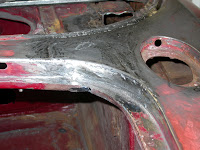After completing the welding, I filled all the seams in the inside and trunk with Eastwood Seam Caulk, let it set up then primed the interior and truck.
I needed to let that dry, so I took a little trip over to O.O. Deny Park in Kirkland to view some Citroens that were gathering there for a small weekend outing. I know! A British car guy going to look at French cars! But really, I’m just a car guy! Got a chance to ride in a DS! OMG, the Brits really don’t have anything on this car unless it’s a Rolls! What a ride! I also got a comparison ride in a 2CV. Yes, very different, but some the same. Kind of makes me want to venture into new fields…HOLD ON! I need to get what I got running first!
So back to the garage and the paint can! Painted the entire interior and most of the trunk, until I ran out of paint. Very happy with the results and feel like I’m really moving forward.


To prep for doing the exterior body work, I need to re-hang the door, but I wanted to take all the insides, glass and chrome off first that way I can get a good re-spray, as well as kill any rust inside the doors (thankfully, very little!). However, I have never taken the glass out of these doors before and found out that there are some tricks! It took about three hours to get the right hand front and back doors stripped completely. But they are done and painted with rust encapsulater. So I’m ready to hang them. And now that I know how to do this, the left hand side will be much easier!
An interesting note: The power window motors are AC Delco parts! I’m glad they are not Lucas!



I pulled out the truck lid, which I had stored away since I took it off in October and realized just how much rust was inside this thing! I removed all the shinny bits and started scrubbing out the inside. I need to remove some of the adhesive used to hold the sound deadening padding (which was good at holding condensation and rusting the metal) before I can paint with rust encapsulater. Since a good portion of the trunk lid will be visible, I’m going to paint it with the exterior color and clear coat it. It will look really nice.
Finally, I put the trunk lid on the car and just to see how much work I need to do to the body and found that it fits pretty well. I did a good job at getting the right corner of the body the correct shape, which is good. I’ll need to do some filler work, but I expected that. The biggest problem is around the left rear where the car had been rear-ended. There was a lot of filler in this area before and I really don’t want to fill it back, so I think I’m going to concentrate on getting the metal back out to the correct shape. There is also a problem around the top right back corner that will require some serious hammer work. But I knew I had work to do there.
So, I’ve got a gallon of Evencoat Rage Gold on order from Eastwood that I hope to have by the weekend! I’m looking forward to doing the body work. It’s been a long road here, but it finally feels like I’m really moving forward!





















